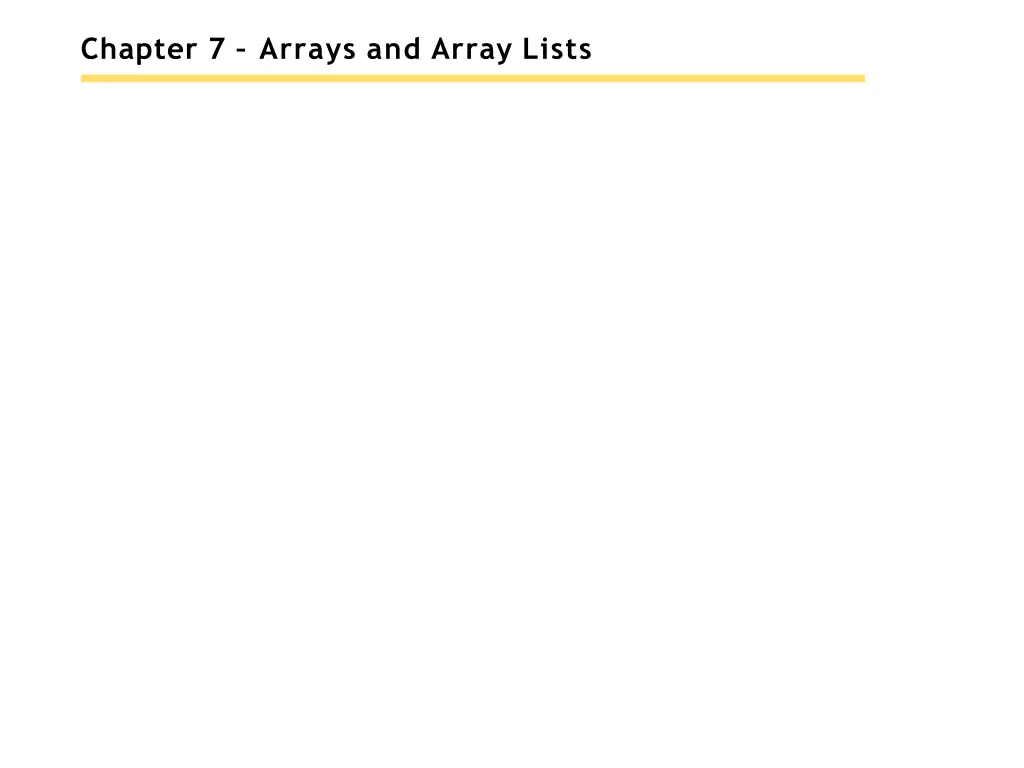
Working with Arrays and Array Lists
Explore the concept of arrays and array lists in Java, including common tasks like adding, removing, and accessing elements. Learn how to use ArrayLists effectively and understand key algorithms for array processing. Dive into two-dimensional arrays and grasp the importance of regression testing.
Download Presentation

Please find below an Image/Link to download the presentation.
The content on the website is provided AS IS for your information and personal use only. It may not be sold, licensed, or shared on other websites without obtaining consent from the author. If you encounter any issues during the download, it is possible that the publisher has removed the file from their server.
You are allowed to download the files provided on this website for personal or commercial use, subject to the condition that they are used lawfully. All files are the property of their respective owners.
The content on the website is provided AS IS for your information and personal use only. It may not be sold, licensed, or shared on other websites without obtaining consent from the author.
E N D
Presentation Transcript
Chapter Goals To collect elements using arrays and array lists To use the enhanced for loop for traversing arrays and array lists To learn common algorithms for processing arrays and array lists To work with two-dimensional arrays To understand the concept of regression testing
Array Lists An array list stores a sequence of values whose size can change. An array list can grow and shrink as needed. ArrayList class supplies methods for many common tasks, such as inserting and removing elements. An array list expands to hold as many elements as needed.
Declaring and Using ArrayLists To declare an array list of strings ArrayList<String> names = new ArrayList<String>(); To use an array list import java.util.ArrayList; ArrayList is a generic class Angle brackets denote a type parameter Replace String with any other class to get a different array list type
Declaring and Using ArrayLists ArrayList<String> is first constructed, it has size 0 Use the add method to add an object to the end of the array list: names.add("Emily"); // Now names has size 1 and element "Emily" names.add("Bob"); // Now names has size 2 and elements "Emily", "Bob" names.add("Cindy"); // names has size 3 and elements "Emily", "Bob", and "Cindy" The size method gives the current size of the array list. Size is now3 Figure 17 Adding an Array List Element with add
Declaring and Using ArrayLists To obtain an array list element, use the get method Index starts at0 To retrieve the name with index 2: String name = names.get(2); // Gets the third element of the array list The last valid index is names.size() - 1 A common boundserror: int i = names.size(); name = names.get(i); // Error To set an array list element to a new value, use the set method: names.set(2, "Carolyn");
Declaring and Using ArrayLists An array list has methods for adding and removing elements in the middle. This statement adds a new element at position 1 and moves all elements with index 1 or larger by one position. names.add(1, "Ann") The remove method, removes the element at a givenposition moves all elements after the removed element down by one position and reduces the size of the array list by1. names.remove(1); To print an array list: System.out.println(names); // Prints [Emily, Bob, Carolyn]
Declaring and Using ArrayLists Figure 18 Adding and Removing Elements in the Middle of an Array List
Usingthe Enhanced for Loop with Array Lists You can use the enhanced for loop to visit all the elements of an array list ArrayList<String> names = . . . ; for (String name : names) { System.out.println(name); } This is equivalent to: for (int i = 0; i < names.size(); i++) { String name = names.get(i); System.out.println(name); }
Copying Array Lists Copying an array list reference yields two references to the same array list. After the code below is executed Both names and friends reference the same array list to which the string "Harry" was added. ArrayList<String> friends = names; friends.add("Harry"); Figure 19 Copying an Array List Reference To make a copy of an array list, construct the copy and pass the original list into the constructor: ArrayList<String> newNames = new ArrayList<String>(names);
Working with Array Lists ArrayList<String> names = new ArrayList<String>(); Constructs an empty array list that can hold strings. names.add("Ann"); names.add("Cindy"); Adds elements to theend. Prints [Ann, Cindy]. System.out.println(names); Inserts an element at index 1. names is now [Ann, Bob, Cindy]. names.add(1, "Bob"); Removes the element at index 0. names is now [Bob, Cindy]. names.remove(0); Replaces an element with a different value. names is now [Bill, Cindy]. names.set(0, "Bill"); Gets anelement. String name = names.get(i); String last = names.get(names.size() - 1); Gets the lastelement. ArrayList<Integer> squares = new ArrayList<Integer>(); for (int i = 0; i < 10; i++) Constructs an array list holding the first tensquares. { squares.add(i * i); }
Wrapper Classes You cannot directly insert primitive type values into array lists. Like truffles that must be in a wrapper to be sold, a number must be placed ina wrapper to be stored in an array list. Use the matching wrapper class.
Wrapper Classes To collect double values in an array list, you use an ArrayList<Double>. if you assign a double value to a Double variable, the number is automatically put into a box Called auto-boxing: Automatic conversion between primitive types and the corresponding wrapperclasses: Double wrapper = 29.95; Wrapper values are automatically unboxed to primitivetypes double x = wrapper; Figure 20 A Wrapper Class Variable
Using Array Algorithmswith Array Lists The array algorithms can be converted to array lists simply by using the array list methods instead of the array syntax. Code to find the largest element in an array: double largest = values[0]; for (int i = 1; i < values.length; i++) { if (values[i] > largest) { largest = values[i]; } } Code to find the largest element in an array list double largest = values.get(0); for (int i = 1; i < values.size(); i++) { if (values.get(i) > largest) { largest = values.get(i); } }
Storing Input Values in an ArrayList To collect an unknown number of inputs, array lists are much easier to use than arrays. Simply read the inputs and add them to an array list: ArrayList<Double> inputs = new ArrayList<Double>(); while (in.hasNextDouble()) { inputs.add(in.nextDouble()); }
Removing Matches To remove elements from an array list, call the remove method. Error: skips the element after the moved element ArrayList<String> words = ...; for (int i = 0; i < words.size(); i++) { String word = words.get(i); if (word.length() < 4) { Remove the element at index i. } } Concrete example Should not increment i when an element is removed
Removing Matches Pseudocode If the element at index i matches the condition Remove the element. Else Increment i. Use a while loop, not a for loop int i = 0; while (i < words.size()) { String word = words.get(i); if (word.length() < 4) { words.remove(i); } else { i++; } }
Choosing Between Array Lists andArrays For most programming tasks, array lists are easier to use than arrays Array lists can grow andshrink. Arrays have a nicersyntax. Recommendations If the size of a collection never changes, use an array. If you collect a long sequence of primitive type values and you are concerned about efficiency, use anarray. Otherwise, use an arraylist.
section_7/LargestInArrayList.java 1 2 3 4 5 6 7 public class LargestInArrayList 8 { 9 public static void main(String[] args) 10 { 11 ArrayList<Double> values = new ArrayList<Double>(); 12 13 14 15 16 17 18 19 20 21 22 23 24 25 26 27 28 29 30 31 32 33 34 35 for (double element : values) Program Run: import java.util.ArrayList; import java.util.Scanner; /** This program reads a sequence of values and prints them, marking the largest value. */ //Read inputs System.out.println("Please enter values, Q to quit:"); Scanner in = new Scanner(System.in); while (in.hasNextDouble()) { values.add(in.nextDouble()); } //Find the largest value double largest = values.get(0); for (int i = 1; i < values.size(); i++) { if (values.get(i) > largest) { largest = values.get(i); } } // Print all values, marking the largest Please enter values, Q to quit: 35 80 115 44.5 Q 35 80 115 <== largest value 44.5
Self Check 7.35 Declare an array list primes of integers that contains the first five prime numbers (2, 3, 5, 7, and 11). Answer: ArrayList<Integer> primes = new ArrayList<Integer>(); primes.add(2); primes.add(3); primes.add(5); primes.add(7); primes.add(11);
Self Check 7.36 Given the array list primes declared in Self Check 35, write a loop to print its elements in reverse order, starting with the last element. Answer: for (int i = primes.size() - 1; i >= 0; i--) { System.out.println(primes.get(i)); }
Self Check 7.37 What does the array list names contain after the following statements? ArrayList<String> names = new ArrayList<String>; names.add("Bob"); names.add(0, "Ann"); names.remove(1); names.add("Cal"); Answer: "Ann", "Cal"
Self Check 7.38 What is wrong with this code snippet? ArrayList<String> names; names.add(Bob); Answer: The names variable has not been initialized.
Self Check 7.39 Consider this method that appends the elements of one array list to another: public void append(ArrayList<String> target, ArrayList<String> { for (int i = 0; i < source.size(); i++) { target.add(source.get(i)); } } source) What are the contents of names1 and names2 after these statements? ArrayList<String> names1 = new ArrayList<String>(); names1.add("Emily"); names1.add("Bob"); names1.add("Cindy"); ArrayList<String> names2 = new ArrayList<String>(); names2.add("Dave"); append(names1, names2); Answer: names1 contains "Emily", "Bob", "Cindy", "Dave"; names2 contains "Dave"
Self Check 7.40 Suppose you want to store the names of the weekdays. Should you use an array list or an array of seven strings? Answer: Because the number of weekdays doesn t change, there is no disadvantage to using an array, and it is easier to initialize: String[] weekdayNames = { "Monday", "Tuesday", "Wednesday", "Thursday", Friday , "Saturday", "Sunday" };
Self Check 7.41 The ch07/section_7 directory of your source code contains an alternate implementation of the problem solution in How To 7.1 on page 330. Compare the array and array list implementations. What is the primary advantage of the latter? Answer: Reading inputs into an array list is much easier.
Regression Testing Test suite: a set of tests for repeated testing Cycling: bug that is fixed but reappears in later versions Regression testing: involves repeating previously run tests to ensure that known failures of prior versions do not appear in new versions
Regression Testing -Two Approaches Organize a suite of test with multiple tester classes: ScoreTester1, ScoreTester2, ... public class ScoreTester1 { public static void main(String[] args) { Student fred = new Student(100); fred.addScore(10); fred.addScore(20); fred.addScore(5); System.out.println("Final score: " + fred.finalScore()); System.out.println("Expected: 30"); } } Provide a generic tester, and feed it inputs from multiple files.
section_8/ScoreTester.java Generic tester: 1 import java.util.Scanner; 2 3 public class ScoreTester 4 { 5 public static void main(String[] args) 6 { 7 Scanner in = new Scanner(System.in); 8 double expected = in.nextDouble(); 9 Student fred = new Student(100); 10 while (in.hasNextDouble()) 11 { 12 if (!fred.addScore(in.nextDouble())) 13 { 14 System.out.println("Too many scores."); 15 return; 16 } 17 } 18 System.out.println("Final score: " + fred.finalScore()); 19 System.out.println("Expected: " + expected); 20 } 21 }
Input and Output Redirection Section_8/input1.txt 30 10 20 5 Type the following command into a shell window Inputredirection java ScoreTester < input1.txt Program Run: Final score: 30 Expected: 30 Output redirection: java ScoreTester < input1.txt > output1.txt
Self Check 7.42 Suppose you modified the code for a method. Why do you want to repeat tests that already passed with the previous version of the code? Answer: It is possible to introduce errors when modifying code.
Self Check 7.43 Suppose a customer of your program finds an error. What action should you take beyond fixing the error? Answer: Add a test case to the test suite that verifies that the error is fixed.
Self Check 7.44 Why doesn't the ScoreTester program contain prompts for the inputs? Answer: There is no human user who would see the prompts because input is provided from a file.






















